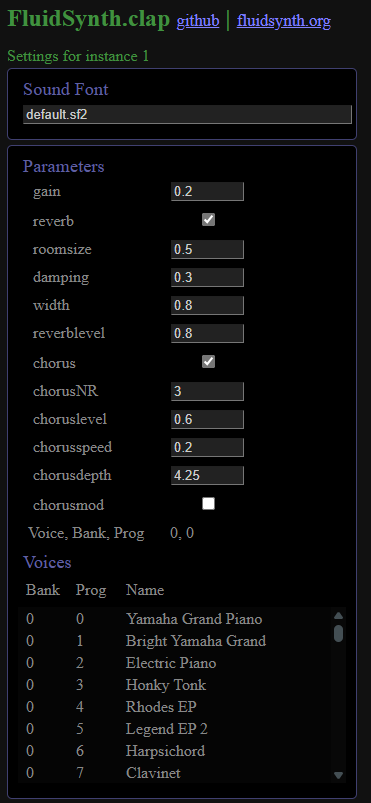Ref / Hz.Plugins / FluidSynth
Hz.Filt, Hz.Echo, Hz.Delay, Hz.Reverb
Hz.Mix, Hz.LFO, Hz.ADSR
see also Hz.Builtins, Plugin Explorer, Hz.Plugins Examples
Intro
FluidSynth.clap is a simple, open source bridge to
the FluidSynth soundfont synthesizer in the
form of a CLAP plugin.
For your convenience, Hz includes FluidSynth along with
its Hz.Plugins suite. Source-code and builds for FluidSynth.clap
can also be found on github.
Presets, Soundfonts
To make any sound using FluidSynth you must provide it with a soundfont file.
A default soundfont is part of the Hz distribution but additional
soundfont files can easily be found on the internet. The go-to starter
soundfont is FluidR3_GM.sf2 and it is the one we include as default.sf2.
FluidSynth.clap looks for a default soundfont according to these
platform-specific conventions:
| platform | type | location |
|---|---|---|
| Windows | system | C:/Program Files/Common Files/Sounds/Banks/default.sf2 |
| Windows | user | $LOCALAPPDATA/Sounds/Banks/default.sf2 |
| MacOS | system | /Library/Audio/Sounds/Banks/default.sf2 |
| MacOS | user | $HOME/Library/Audio/Sounds/Banks/default.sf2 |
| Linux | system | /usr/share/sounds/sf2/default.sf2 |
| Linux | custom | /usr/local/share/sounds/sf2/default.sf2 |
| Linux | user | $HOME/Documents/sounds/sf2/default.sf2 |
To override these defaults, we employ CLAP's preset extension to allow you
to request an alternate soundfont file. In other words, .sf2 files are
the preset files compatible with this plugin. To load a soundfont you should
be able to request a preset load via your favorite CLAP host application.
In Hz this looks like this:
let fluidSynth = scene.NewAnode("FluidSynth", {preset:pathToSf2});
Here are a few sources for free soundfonts:
State Save/Restore
We support the clap.state extension but since the state includes
the filepath to the active soundfont, state files may not be
perfectly portable.
WebGUI
The version of FluidSynth.clap that is included with Hz implements
a simple interface using its webview gui subsystem.
Here's a look:

Parameters
In typical usage, FluidSynth exposes a large collection of "canned" instrument
sounds that are selected by the instrument index. Thus, very little user-interface
is required. Just select instrument/bank indices in your sound font. Most CLAP
hosts offer a stripped-down parameter editing interface which may suffice to
select different gain and program settings.
The General Midi standard defines a standard mapping
between an index and an instrument. Soundfonts with GM in their name
purport to follow this convention.
Here are the exposed/supported fluidsynth parameters and their ids.
| id range | description | value range | default |
|---|---|---|---|
| 0 | gain | 0-10 | 0.2 |
| 1 | reverb | 0,1 | 1 |
| 2 | roomsize | 0-1.2 | 0.2 |
| 3 | damping | 0-1 | 0.0 |
| 4 | width | 0-100 | .5 |
| 5 | reverblevel | 0-1 | 0.9 |
| 6 | chorus | 0,1 | 1 |
| 7 | chorusNR | 0-99 | 3 |
| 8 | choruslevel | 0-10 | 2 |
| 9 | chorusspeed | 0-1 | .3 |
| 10 | chorusdepth | 0-256 | 8 |
| 11 | chorusmod | 0,1 | 1 |
| 32-47 | program associated with midi chans 0-15 | 0-127 | 0 |
| 48-63 | bank associated with midi chans 0-15 | 0-127 | 0 |
More details on these settings can be found in the fluidsynth docs.